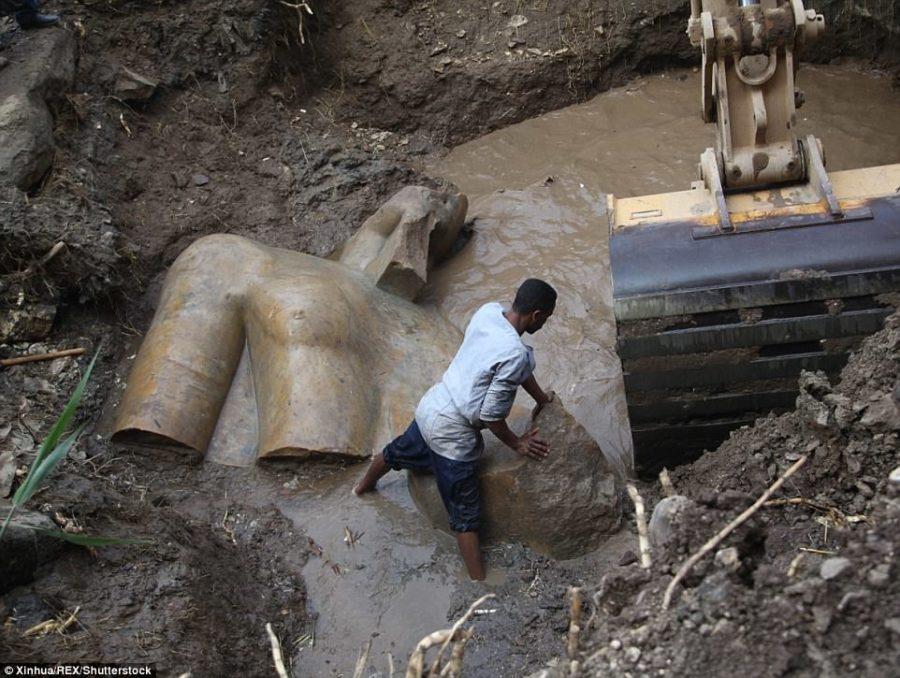Puzzle Over The Giant Pharaoh Statue
March 21, 2017
There was certainly some deep thinking involved when Archaeologists dug out a broken 29-foot statue of an Egyptian Pharaoh.
A team of German and Egyptian Archaeologists was far more than thrilled upon their discovery in the flooded wastelands of Cairo on March 9, 2017. The team uncovered a giant quartzite statue from a groundwater center in a working-class neighborhood. It was originally estimated to being about 3,000 years old, and the figure was believed to be that of famous Pharaoh Ramses II. However, new evidence revealed a stark difference from the former assumption of the statue’s true identity.
Because previous remains lacked inscription, archaeologists could only deduce the statue’s identity as Ramses II, because of its relatively close location to an ancient temple, that was once built to honor the pharaoh. Furthermore, a smaller limestone statue of Ramses II’s grandson Pharaoh Seti II on the site pointed to the likelihood of the several ton figure being the great pharaoh.
Ramses II is notable today for having one of the longest reigns over Egypt. With an impressive 60 year rule from 1279 to 1213 B.C., Ramses is remembered for increasing Egyptian borders through his victorious military conquests as far as Syria and modern-day Sudan. So naturally, the Archaeologist community’s hopes fell short when new information debunked their theory about the discovery.
On March 14th, further extracting of the relic exposed an actually hidden inscription of hieroglyphics, which may or may not provide the name of the real pharaoh.
According to BBC, Egypt’s Antiquities Minister “Khaled el-Anani told a news conference [that] the statue [is] almost certainly Psamtek I, who ruled between 664 and 610BC.” Psamtek I ruled some 6oo years after Ramses II and is remembered for establishing peace and stability within the kingdom after years of warfare and conflict.
Impressive nonetheless, many experts remain optimistic about their find and its value. Anani himself noted that even though the statue may not be a well-known historical figure,”if it belongs to [Psamtek I], then it is the largest statue of the Late Period that was ever discovered in Egypt,” making this find a certain breakthrough in Archaeological work.
Still largely disputable between the experts, there is speculation that the statue belongs to both pharaohs. As stated in the San Francisco Chronicle Anani told the press that there is a possibility that Ramses II was originally depicted by the antiquity, but Psamtek ordered to reuse the statue to match his own profile. If that is indeed the case, then this would be a rare occurrence in Egypt’s history where two rulers this largely apart would share a connection that we know of today.
Regardless of the true identity, this statue will be moved from the slums of Heliopolis to the Egyptian museum in central Cairo. A Cinderella story of its own, this massive artifact is now facing a challenging task of being pieced together and restored before being presented to the public.
WHHS student of Egyptian decent Maggie Kormann shared her enthusiasm about the story. “I’ve heard about the statue,” she said, “I think it’s definitely possible that the statue could have belonged to Ramses II and then to Psamtek I. Anyway it’s really cool if it did.”
However, another sophomore student Sarah Shardam expressed her doubts about this possibility.
“I think that’s highly unlikely. Maybe it was some sort of cover-up. I don’t know. I mean it is possible that the statue does not belong to either of them. But if it did belong to both Ramses II and Psamtek I, it would be amazing because that never really happens!” Shardam said.
















